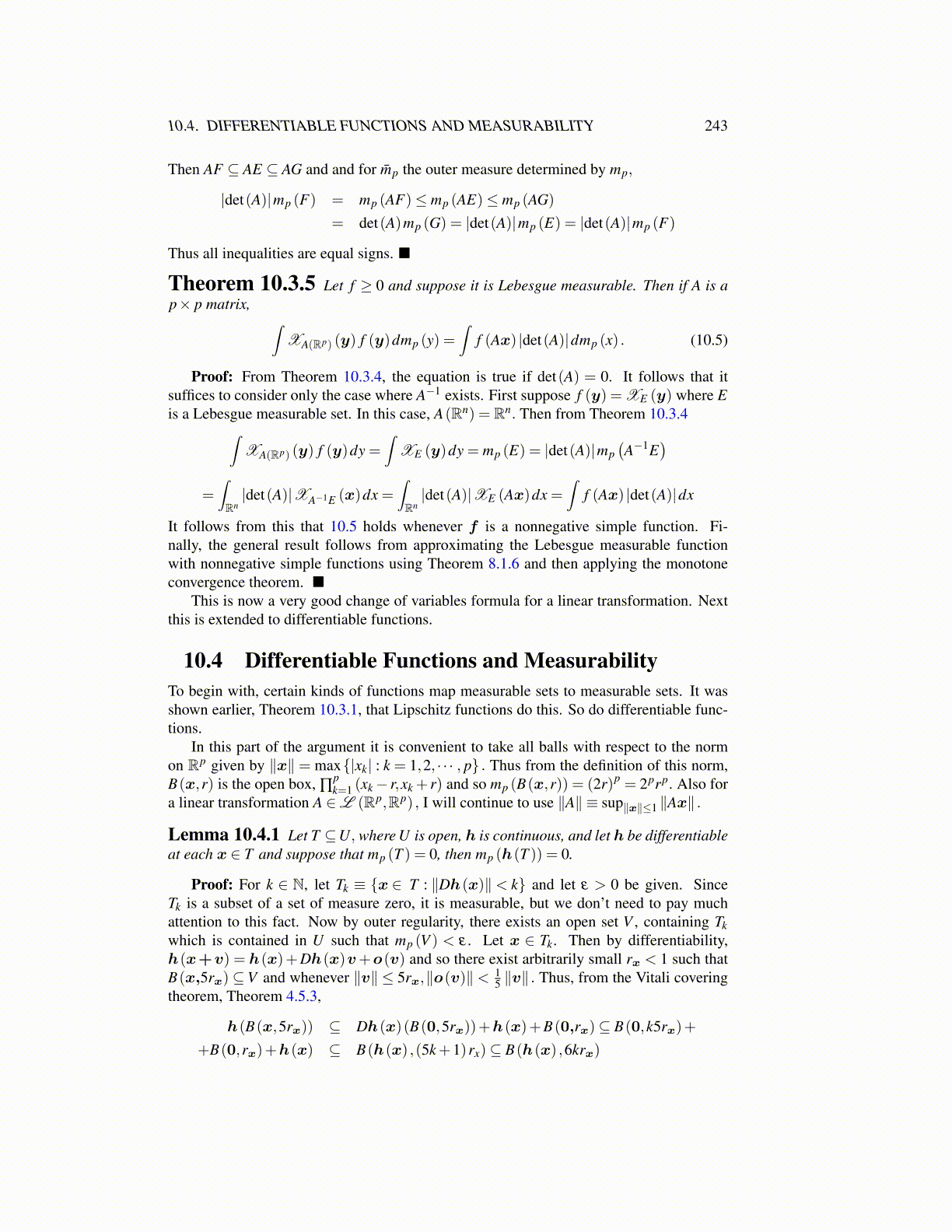
10.4. DIFFERENTIABLE FUNCTIONS AND MEASURABILITY 243
Then AF ⊆ AE ⊆ AG and and for m̄p the outer measure determined by mp,
|det(A)|mp (F) = mp (AF)≤ mp (AE)≤ mp (AG)
= det(A)mp (G) = |det(A)|mp (E) = |det(A)|mp (F)
Thus all inequalities are equal signs. ■
Theorem 10.3.5 Let f ≥ 0 and suppose it is Lebesgue measurable. Then if A is ap× p matrix, ∫
XA(Rp) (y) f (y)dmp (y) =∫
f (Ax) |det(A)|dmp (x) . (10.5)
Proof: From Theorem 10.3.4, the equation is true if det(A) = 0. It follows that itsuffices to consider only the case where A−1 exists. First suppose f (y) = XE (y) where Eis a Lebesgue measurable set. In this case, A(Rn) = Rn. Then from Theorem 10.3.4∫
XA(Rp) (y) f (y)dy =∫
XE (y)dy = mp (E) = |det(A)|mp(A−1E
)=∫Rn|det(A)|XA−1E (x)dx =
∫Rn|det(A)|XE (Ax)dx =
∫f (Ax) |det(A)|dx
It follows from this that 10.5 holds whenever f is a nonnegative simple function. Fi-nally, the general result follows from approximating the Lebesgue measurable functionwith nonnegative simple functions using Theorem 8.1.6 and then applying the monotoneconvergence theorem. ■
This is now a very good change of variables formula for a linear transformation. Nextthis is extended to differentiable functions.
10.4 Differentiable Functions and MeasurabilityTo begin with, certain kinds of functions map measurable sets to measurable sets. It wasshown earlier, Theorem 10.3.1, that Lipschitz functions do this. So do differentiable func-tions.
In this part of the argument it is convenient to take all balls with respect to the normon Rp given by ∥x∥ = max{|xk| : k = 1,2, · · · , p} . Thus from the definition of this norm,B(x,r) is the open box, ∏
pk=1 (xk− r,xk + r) and so mp (B(x,r)) = (2r)p = 2prp. Also for
a linear transformation A ∈L (Rp,Rp) , I will continue to use ∥A∥ ≡ sup∥x∥≤1 ∥Ax∥ .
Lemma 10.4.1 Let T ⊆U, where U is open, h is continuous, and let h be differentiableat each x ∈ T and suppose that mp (T ) = 0, then mp (h(T )) = 0.
Proof: For k ∈ N, let Tk ≡ {x ∈ T : ∥Dh(x)∥< k} and let ε > 0 be given. SinceTk is a subset of a set of measure zero, it is measurable, but we don’t need to pay muchattention to this fact. Now by outer regularity, there exists an open set V , containing Tkwhich is contained in U such that mp (V ) < ε . Let x ∈ Tk. Then by differentiability,h(x+v) = h(x)+Dh(x)v+o(v) and so there exist arbitrarily small rx < 1 such thatB(x,5rx)⊆V and whenever ∥v∥ ≤ 5rx,∥o(v)∥< 1
5 ∥v∥ . Thus, from the Vitali coveringtheorem, Theorem 4.5.3,
h(B(x,5rx)) ⊆ Dh(x)(B(0,5rx))+h(x)+B(0,rx)⊆ B(0,k5rx)+
+B(0,rx)+h(x) ⊆ B(h(x) ,(5k+1)rx)⊆ B(h(x) ,6krx)